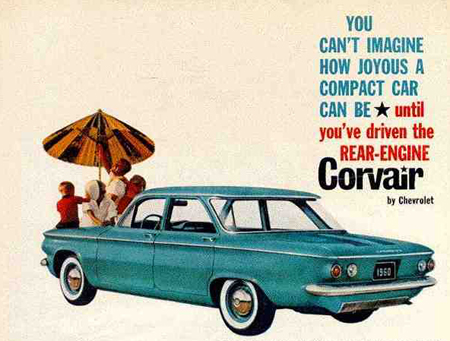The Corvair was General Motors’ counter to the increasing numbers of imported cars that were nibbling away at the low end of the US market place.
Though quite large by European standards, the Chevrolet Corvair was typical of the new compact class in its native North America.

Market leader in the upper segments, Chevrolet had no small car in its range. Ed Cole, a career GM engineer and now general manager of Chevrolet planned a light, low cost and sporty model which would appeal to adventurous and younger price-conscious buyers. It was squarely aimed at cars like the Renault Dauphine and the VW Beetle.
Cole who designed the “small block” Chevrolet V8 engine which is still made for competition cars 50 years later, decided to use the new Corvair to execute an idea he had had for some years and that was to put the engine at the rear. The success in the US of VW endowed the concept with some respectability and a relatively small air cooled engine would allow the car a lower silhouette and enhance passenger space within compact overall dimensions.

Technically, it was remarkably advanced with its 2.3 litre flat six sat so low there was room to install the spare wheel in the engine compartment. Light enough not to need power steering and elegantly styled, the Chevrolet compact sold well from its 1959 introduction, the plant turning out over 200,000 units a year until 1965.
There was a variety of body styles – the initial four door saloon quickly followed by two door convertible and coupé types, a station wagon and even a van version obviously inspired by the VW Microbus. The two door car became known as the poor man’s Porsche and a short-lived turbocharged version, the Monza Spyder, was rated at 180bhp.
The Corvair’s originality brought Chevrolet a new seam of customers who might otherwise have opted for Beetles or Volvos. By contrast, the Corvair’s contemporary the similarly sized Ford Falcon stole sales disastrously from Ford’s bigger and more profitable sedans.
Attractive as it was, the Corvair was not without problems: oily smells tended to emanate from the heating system and the unequal rates of expansion of alloy and iron caused cylinder head problems. The Corvair was advanced, but it was also built to a price so that it could be marketed initially at $1500.
This meant not just a basic specification – a three speed manual gearbox or two speed automatic, it also entailed certain compromises: if the Corvair pioneered unibody build – its glass and doors were integral parts of the construction, this contrasted with a relatively crude swing axle rear suspension.
Cheap to make, robust and offering a comfortable ride, the predilection to oversteer was exacerbated by the absence (for cost reasons) of an anti roll bar and in extremis could even allow the car to overturn. It was this weakness that Ralph Nader’s infamous broadside against Detroit, “Unsafe at any Speed,” published in 1965, alighted upon.
A crusading consumerist lawyer, Nader made much of the fact that in order to offset the tendency to oversteer, Chevrolet instructed owners that they should maintain tyre pressures of 15psi (front) but 26psi (rear). However this vital information was frequently not communicated and garages would usually inflate all tyres to the same pressure.
In reality, the early Corvair was hardly worse than other cars in this respect – the swing axle was also used on the Mercedes Benz 220, the Porsche 356 and of course the Beetle. In fact by the time Nader’s book appeared, the Corvair had acquired an independent rear suspension (with anti roll bar) as well as a striking facelift. Alas the damage was done.
Although the Corvair merely occupied some paragraphs in one chapter, the effect was almost as if “Unsafe at any Speed” was an indictment of the Chevrolet compact alone. Sales began to fall off, further wounded by the launch in 1964 of the Ford Mustang which by 1965 included the 271cu in V8 offering far more performance than the now 2.7 litre Corvair.
GM allowed production of the Corvair to continue till 1969, by which time only a trickle was coming off the line. Development of a conventional front engined successor, the Camaro, had been accelerated to meet the runaway success of the Mustang and styling detail intended for a third generation Corvair was instead incorporated in the 70s Camaro, a model which continues today.
In a conservative market, the Corvair was ahead of its time, but its relative failure meant that GM would fatally lose interest in building a lighter, more “European” automobile.

Over the next thirty years, first imported, then locally assembled foreign cars gradually wooed US buyers. When gasolinereached $4/gallon, GM finally had to ask the government for rescue. Ironically the Corvair’s spiritual successor will be the car Chevrolet is forced to make for the marque to survive in the longer term.
As a youngster he used to send race reports on Mallory Park meetings to the Derby Evening Telegraph which unaccountably always failed to print them. For thirty years he produced reports and analysis for other people before turning to motoring journalism and writing about matters rather closer to heart. An old 911, acquired when they were still affordable opened the world of Porsche and today he writes on historical subjects for several Porsche magazines in Europe and the US. He is also the UK correspondent for the classic car weekly, La Vie de l’Auto and keeps a foot in the modern world with a column in Trucking, a transport magazine, and as motoring correspondent for the Irish Police Journal.






